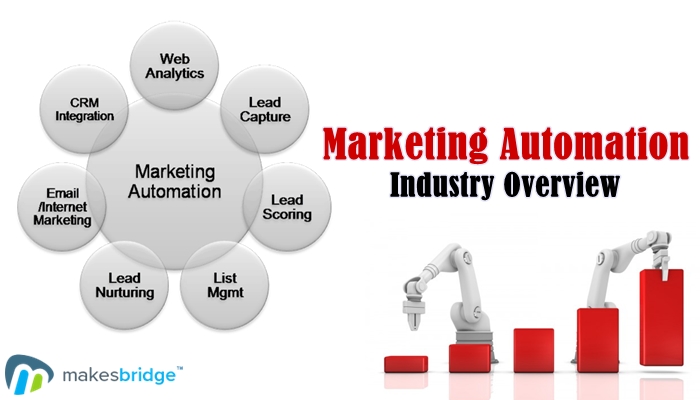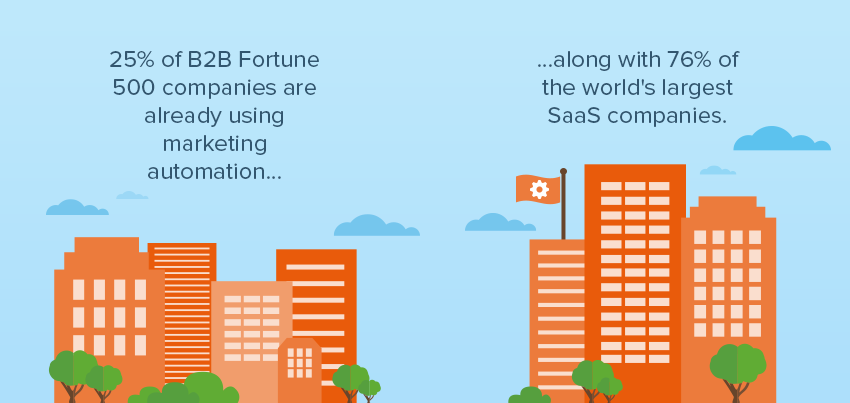Marketing automation refers to the utilization of technology and software platforms to market products/services on multiple channels and automate repetitive tasks. Using marketing automation tools, you can easily communicate the intended messages at a given interval without doing anything manually. From email marketing to business intelligence, prospect tracking, website analysis, traffic overview, source tracking, SMS marketing, social media management, lead nurturing, and sales, everything is being done with the help of these automation platforms. The reason for their popularity is simple: they save time, reduce cost, and optimize performance.
From the largest enterprise to the smallest company, B2B marketers are experiencing change at an unprecedented speed. Proliferation of digital channels has made it more difficult to accurately target prospects with the right messages at the right times. Today’s B2B buying cycle is nearly unrecognizable, as prospects manage more and more of the process themselves, making decisions by researching brand websites and social channels. Most of them do not chat with sales representatives, making it difficult for the companies to nurture prospects. This challenge is being met with the help of an effective integration of technology within the business processes.
According to a September 2013 survey of digital marketers, more than 41% are using marketing automation software, 26% planned to adopt it in 2014, and 33% don’t have plans to use it. Similarly, a study conducted by Sirius Decision states that “marketing automation platforms have a penetration rate of 20% and by the end of 2015, the adoption will grow to 50%.” In addition, the penetration rate is not equal in all industries as the high tech and software industry is demonstrating a much higher than average adoption rate.
Also Read: SMB Marketing Automation Checklist for Software Selection
On the revenue side, marketing automation systems’ revenue was over $750 million in 2013, which was 50% up from a nearly $500 million revenue in 2012. It is expected that by the end of 2015, the industry volume will cross $1 billion and the penetration rate will be between 50 to 60 percent.
Benefits of Marketing Automation:
Key Benefits of Marketing Automation include the following.
- Reduced human error, improved HR performance and increased efficiency of the business.
- An average increase of 77% in revenue.
- 53% higher conversion rate.
- 65% deeper insight into prospect behavior.
- 74% of the top performing companies use automated nurturing and increased their sales by 20%.
- 78% of marketers cite marketing automation as a key factor in improving revenue.
Owing to the same criteria, it is predicted that usage of automation platforms will soar up by 50% in the year 2015.
Types of Automation Platforms:
There are different types of platforms and software that help you in a range of marketing activities. We can divide them primarily into the following categories:
- Business Intelligence Platforms.
- Marketing Automation Platforms.
- Multi-Tasking Platforms.
- Business Intelligence:
These platforms use codes and track user behavior on different platforms like social media, emails, and website pages. It helps marketers understand the prospect’s behavior and whether someone is buying/subscribing to a particular set of products/services or not. Using these platforms, the marketer can determine how many people clicked on, opened the email, bounced, visited the site and which key pages were accessed.
- Marketing Automation:
These platforms focus on a marketing funnel and help marketers manage and convert the prospects. Based on a prospect’s engagement level, he is assigned a particular score and then, using a range of channels, the marketing messages are sent. It is generally known as drip marketing, and is well known for its use in sales force campaigns. This practice is common in business-to-business (B2B), business-to-government (B2G), or high volume business-to-consumer (B2C) sales exercises. Email marketing platforms like MailChimp, ConstantContact, and Makesbridge offer this service.
- Multi-Tasking Platforms:
These are a newer and very popular series of platforms. These platforms help companies in the following areas: 
- Internal Marketing Process.
- Campaigns Management.
- Deep Analytics (social, web, email).
- Tight Integration with 3rd party apps, email and social platforms. Like integration with LinkedIn, Gmail, Salesforce, etc.
- Cloud Apps store different platform contacts at one place.
These platforms are becoming more popular when compared to the other ones. The reason is that they are a one-stop-shop for all marketing needs. Companies are able to manage their internal marketing process, obtain integrated analytics, plan better, and utilize multiple platforms from a single dashboard. HubSpot, Makesbridge, Marketo, and Eloqua can be cited as examples.
Market Trends in Automation Industry:
The marketing automation software landscape is being shaped by a number of significant trends, including:
- Mergers and acquisitions among larger vendors.
- Growth in third-party application ecosystems.
- Platforms expand features well beyond email marketing.
Large technology companies continue to provide cloud-based marketing software or software as a service. They are doing this by making significant acquisitions in the marketing automation space. Look at Oracle as an example. It acquired VA-based Eloqua for $871 million and later in December 2013, it purchased ResponSys for $1.5 billion. More recently, Oracle bought Compendium for content and social media automation and purchased Corente in early 2014. Similarly, HubSpot acquired PrepWork and SalesForce acquired Pardot.
In addition to mergers and acquisitions, we have seen an incredible growth in the third-party applications that are used or integrated with marketing automation software. For example, there are apps for companies to integrate webinar registrations from an outside platform into their marketing automation systems. The emergence of these apps has enabled marketing automation vendors to more quickly broaden their existing platforms’ capabilities. Take the example of “Curata” that offers content curation, discovery and organization. Similarly, Kapsot is another app that offers content marketing workflow management and process integration.
The last point regarding expanded features is the upgrade from mere email marketing to multi-tasking platforms. B2B marketers have a range of channels that are used to communicate the message. For example, over 90% of the US adult population has a smartphone, while the global number of smartphone users is about to cross the 2 billion benchmark. They use their phones for emails, social networking, gaming, buying, and e-trading.
Therefore, the marketer’s job has become more complex as they now have to cover multiple channels. In response, marketing automation platform vendors have expanded beyond their core email marketing capabilities to provide native support for SMS marketing, social media publishing, data analysis, marketing intelligence, telesales, and much more. Several vendors are using APIs to capitalize on the open sharing of information on Facebook, Twitter, and LinkedIn.
Some tools gather information from the social network and add it to contact records, while others create a social media dashboard within the marketing automation platform that enables users to track social media campaigns, prospect activity, landing pages, A/B testing, and much more. The entire campaign is managed from a single dashboard that makes it easier for users to manage and run the campaign.
In short, with the help of marketing automation platform, companies can save their time, reduce human error, effectively manage their campaigns, and improve the performances of sales and marketing teams. The ultimate goal of prospect management and revenue generation can be achieved in an optimal manner if technology integration is used in the process.



